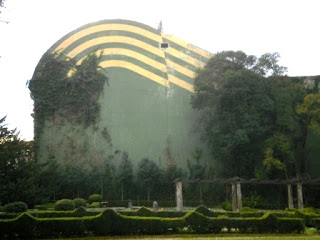Fernando doesn’t want to go to New York: he is perfectly happy with Grado and Asturias. Grado, since it was threaded on the new motorway, has crusted over with apartment buildings and retail warehouses, with the rapidity of that primary school science project where you grow crystals on blotting paper- hardly a jewel. Its surrounding hills have not been scoured and planted with eucalyptus to the same extent as nearby Salas or the area around Avilés but the untidy invader can still be seen in plantations waving its slender trunk in the wind and rain. Ah, the rain.
The area is shrouded in clouds that blow in off the sea, nestle around the mountains and squeeze out their juices on a landscape that is as green as Ireland when the sun shines. Grado, where the Nalón and Cubia meet, is shrouded in morning mist that lazily wafts up the valleys as the day progresses. The pavement cracks grow moss and mould, the walls of the tenement buildings ooze black from car pollution trapped in the moist air and the few remaining tiled roofs sprout ferns and grasses. Grado’s element is water: it falls from the sky, it rises from the ground and it hangs in the air in dense banks of humidity. It’s a curious choice for sentimental affection.
Yet Fernando doesn’t want to go to New York. He is absolutely serious. This is no petulant dogmatism like that of my friend Freddy from Namibia who refused to go to the USA because of the way it had raped his home country. No, Fernando is happy in the land of mists and moulds. He is happy living with his mother at the age of fifty, allowing the women in the house to tell him what to wear, eat and watch on the television and he is happy walking out at the weekend to the market in Grado, where he will see familiar friends de toda la vida to have a coffee and hang out.
When he walks through the streets of a town that has been bludgeoned by development I wonder if Fernando sees a different place, the Grado of his childhood. And since these modern buildings will not last for more than a generation, will the youth of today, grown old and nostalgic, look back on these times as though they were innocent?











